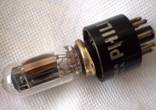RESTORATION
A collection must be seen as an ordered and classified reunion of objects which represents a time in history. When a radio is found, it’s usually “old”, far to be considered an “antique” object worth of being a collection item.
Dealing with restoration is too far beyond simply “making the radio talk”. The goal is to make it possible that a receiver meets its original condition, reflecting its creation moment at the most.
Radios abandoned for a long time suffer with sun light lack or excess, humidity and plagues, rats and mainly termites. Corrosion is one of the greatest steel components enemies as the chassis and components.
But, the biggest harmful action is human. Many radios, when open, show the collector unsuitable practices from electro technicians or dealers. The pictures show works of rare skills, but also show lack of any commitment with originality . .
At the picture in the left, two modern diodes and capacitors fixed to a tube base. A bizarre solution to a Swedish Deso-Dewald radio rectifying, made a long time before the commercialization of these diodes!
In the picture below, a miniwatt tube adapted to fit in a bigger tube holder.

The components changing should be done under rigorous criteria, using the same tubes or the equivalent of the time. Pieces replacement for more modern ones will be under some rules: impossibility to get the original one; the replaced component must perform the same function as the original one, difficulty to get batteries to DC radios.
Research
Knowing the radio features is the beginning. Internet and experienced people are the best resources. From them, information with historical value and restoration will avoid getting “a pig in a poke”.
Research will show the scheme, the kind of current and the set power tensions. When I received an Erla (Electrical Research Labs) radio, made in 1935, it had two output tubes burned. Working with 32 volts in discharge current batteries, it certainly was turned on by some layman on 220 volts alternating current... Searching and buying these tubes coast me some money!
Cleaning and Painting
Efficient cleaning demands the cabinet chassis to be removed, what also demands a lot of care in order not to damage it: they are 70 years old or even more! Pieces such as the radio dial and the knobs (buttons) can be easily broken at this step.
A good chassis cleaning demands the removal of the tubes and the speaker disconnection. Besides the dust, grease and insect’s removal, the chassis oxidation demands acids to clean the rust. It’s effective to use a chloridric acid solution. It’s possible to find products that remove corrosion and cover the steel with a phosphatic layer, avoiding a new corrosion.
 Tips: Be careful when cleaning the dial: The painting and the letters can be erased easily! And make sure to wear gloves, mask and to be in a well-ventilated place when dealing with acids, paints and other chemicals! Tips: Be careful when cleaning the dial: The painting and the letters can be erased easily! And make sure to wear gloves, mask and to be in a well-ventilated place when dealing with acids, paints and other chemicals!
|